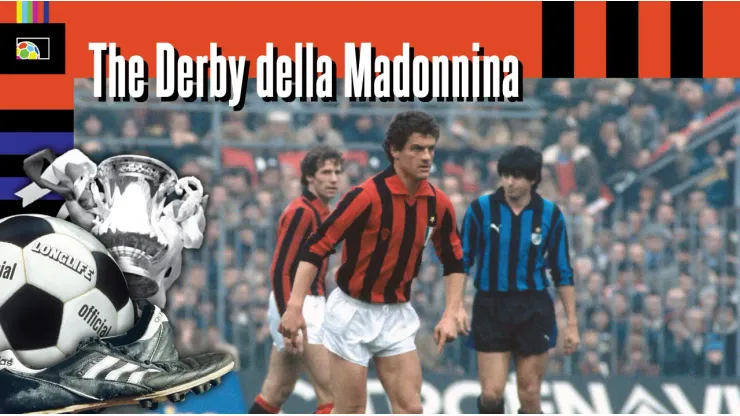Amidst the vibrant fusion of fashion, art, and culture in the heart of Milan, a unique form of passion claims the spotlight – the Derby della Madonnina, a soccer rivalry that goes beyond mere competition. For more than a century, this showdown between the city’s powerhouses, AC Milan and Inter, has entranced fans. To embrace this incredible story, here’s the history of the Milan derby.
Whenever these two squads collide head-on in the derby encounter, the entire city is gripped by suspense. However, were it not for an internal disagreement that transpired in the 20th century, this storied rivalry might never have come into being.
How AC Milan and Inter came to be
The Milan Foot-Ball and Cricket Club came into existence in December 1899, largely due to the dedicated efforts of a group of English individuals. Among them, Herbert Kilpin, originally from Nottingham, played a pivotal role in the club’s foundation. He helped introduce the beautiful game to the capital of Lombardy and served as the team’s inaugural coach and a key player during their early triumphs.
Kilpin received support from Alfred Edwards, a Shropshire-based businessman who assumed the role of the club’s first president. Additionally, notable players like Samuel Richard Davies and David Allison, who later became the team captain, were part of this initial effort.
Regrettably, shortly after the club’s establishment, internal conflicts began to surface, mirroring the political tensions of the era in Italy, ultimately leading to a division within the club. The emergence of nationalism in Italy had a profound impact on the structure of the country’s football system. In 1908, the Italian Football Federation introduced two distinct titles: the Federal Championship, which allowed foreign players, and the Italian Championship, which did not.
Our Pick:Includes: Champions League, Europa League, Serie A, NWSL, Argentine Primera, Brasileirão, Scottish Premiership, Women's Super League, & More |
|
Ironically, this division regarding the inclusion of foreign players also existed within the club, much to the disappointment of Herbert Kilpin. One year later, a group of dissatisfied members broke away from the club, forming a separate team that better aligned with Kilpin’s internationalist ideals: Football Club Internazionale.
Inter embraced the principle of internationalism and, as a result, their roster included several Swiss players. With fewer restrictions on player eligibility, it was not surprising that they achieved greater success in the subsequent decades than the Rossoneri, who would not win another Scudetto until 1951.
Nevertheless, Inter’s breakaway was inspired by individuals like the artist Giorgio Muggiani and received support from intellectuals and the wealthy, which also cast them as a club of the elite.
When was the first derby game?
There is a degree of uncertainty surrounding the first encounter between these two teams. Some contend that the initial game transpired in Switzerland in 1908 during the Chiasso Cup final, which the Rossoneri won 2-1. However, historical records and evidence about this event are somewhat incomplete. Nevertheless, it’s believed that on a cold day in January 1909, the inaugural encounter between the two sides occurred, laying the foundation for a rivalry that would stand the test of time.
In their first officially documented clash in the Prima Categoria, which at the time served as Italy’s premier domestic competition, comparable to Serie A, AC Milan again emerged as victors with a scoreline of 3-2. It was a result that signified the commencement of a vibrant and enduring soccer rivalry.
Why is it called Derby della Madonnina?
An intriguing facet of the Milan Derby is its distinctive moniker, the ‘Derby della Madonnina.’ This title is a tribute to the statue of the Virgin Mary, known as the Madonnina, which graces the towering spire of Milan’s Duomo di Milano, the city’s grand cathedral.
The iconic narrative behind this moniker harks back to the 1950s when a Nerazzurri supporter taunted their arch-rival fans by proclaiming, “We will bring the Madonna [Virgin Mary] to San Siro!” In a witty response, Milan enthusiasts retorted, saying, “No, we will let her stay on the Duomo!”
This exchange of banter and pride gave rise to the iconic moniker ‘Derby della Madonnina.’ Although this tale originates from Italy, it is simply a widely accepted explanation for the nickname. Thus, it should be interpreted as a legend rather than a historically confirmed fact.
Derby della Madonnina in the 20th century
In the 20th century, the Derby della Madonnina transformed, transcending its local roots to become a global spectacle. It saw AC Milan eventually embracing foreign talent and finding success with them. Their first league title following the split from Inter was secured thanks to the celebrated attacking trio of the Swedish goal-scoring sensation Gunnar Nordahl, alongside his compatriots Gunnar Gren and Nils Liedholm. This formidable triumvirate was so effective that they earned their special acronym, ‘Gre-No-Li.’
In the 1910s, Il Diavolo clinched the Italian championship three times, while the Black and Blues secured their initial Scudetto in 1910. The post-World War II era injected new life into the Derby della Madonnina, as both sides benefited from the presence of legendary players. Milan boasted talents like Gunnar Nordahl and Nils Liedholm, while Inter had stars like Giuseppe Meazza and Mario Corso, all of whom left an indelible mark on the history of the sport.
A while later, the 1980s heralded an influx of exceptional talent to the Milan Derby. Guided by Arrigo Sacchi, the Red and Black outfit fueled by the trio known as the ‘Dutch Trinity’ comprising Ruud Gullit, Frank Rijkaard, and Marco van Basten, asserted their dominance in both domestic and European arenas. Meanwhile, Inter also experienced their own moments of glory, including securing the Serie A title under the management of Giovanni Trapattoni.
In the late ’90s and early 2000s, a sequence of intense confrontations unfolded, further intensified by the Calciopoli scandal. Despite both clubs facing point deductions, their competitive zeal remained unshaken.
Milan Derby in the 21st century
The early 2000s represented a significant transitional period for both Milanese clubs. Milan, guided by the visionary coach Carlo Ancelotti, underwent a revival. The introduction of star players such as Kaka, Andrea Pirlo, and Clarence Seedorf ushered in a new era of success for the Rossoneri. They secured Serie A titles and, notably, claimed the UEFA Champions League trophy in 2003 and 2007, solidifying their influence on European soccer.
Subsequently, they experienced a challenging period, often referred to as their ‘banter era’, while Inter established their supremacy in Serie A during the mid-2000s. Under the stewardship of the enigmatic Jose Mourinho, the Blue and Black side clinched five consecutive league titles. This domestic success was complemented by Mourinho’s tactical acumen and a remarkable squad that included luminaries like Zlatan Ibrahimovic, Wesley Sneijder, and Javier Zanetti.
A standout moment in the Milan Derby during the 21st century was Inter’s remarkable treble-winning season in 2010, which encompassed Serie A, Coppa Italia, and the UEFA Champions League.
Today, the Derby della Madonnina continues to be a prominent event on the soccer calendar. Modern stars such as Romelu Lukaku, Lautaro Martinez, Olivier Giroud, and Rafael Leao have showcased their skills on the San Siro pitch, ensuring that the tradition of the clash remains vibrant.
AC Milan vs Inter history: Head to head, and trophies
The Milan Derby stands out from other derbies worldwide due to its absence of deep-rooted political and religious differences. Instead, it is a rivalry primarily shaped by a straightforward pursuit of sporting excellence, driven by an unwavering hunger for trophies and prestige.
As an integral facet of their remarkable rivalry, both teams have had phases of domestic supremacy over the past century, and they have experienced a resurgence in recent seasons. They share 19 league titles, with their most recent triumphs occurring in 2021 (Inter) and 2022 (Milan), respectively.
In the Coppa Italia, Inter holds the lead, having won nine titles to Milan’s five. Meanwhile, in the Italian Super Cup, the competition is evenly matched, with both sides having secured the trophy seven times in their history.
However, when it comes to continental success, the Rossoneri have the advantage over their rivals with seven UEFA Champions League titles, compared to the Nerazzuri’s has three. It’s worth noting that the latter has clinched three Europa League titles, while the former has yet to ever win one.
In total, as of press time, spanning 238 official matches, Inter maintains the overall advantage with 90 victories, as opposed to Milan’s 79, and there have been 69 draws.
Images: Imago
200+ Channels With Sports & News
- Starting price: $33/mo. for fubo Latino Package
- Watch Premier League, Women’s World Cup, Euro 2024 & Gold Cup
The New Home of MLS
- Price: $14.99/mo. for MLS Season Pass
- Watch every MLS game including playoffs & Leagues Cup
Many Sports & ESPN Originals
- Price: $10.99/mo. (or get ESPN+, Hulu & Disney+ for $14.99/mo.)
- Features Bundesliga, LaLiga, Championship, & FA Cup
2,000+ soccer games per year
- Price: $5.99/mo
- Features Champions League, Serie A, Europa League & Brasileirāo
175 Premier League Games & PL TV
- Starting price: $5.99/mo. for Peacock Premium
- Watch 175 exclusive EPL games per season








